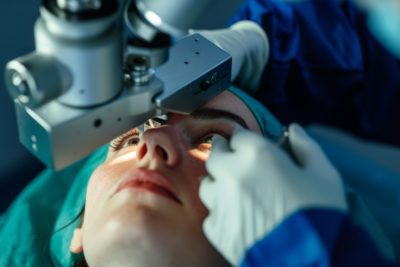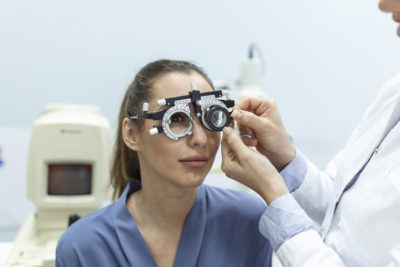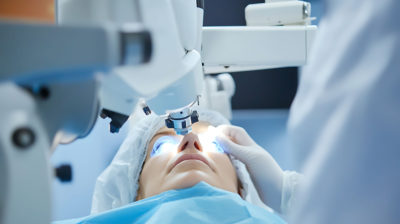I am full of fear and I do my best to avoid complications. I like everything around to be clear as crystal and completely calm- Alfred Hitchcock
Medical science is a field full of intricacies. Ambiguous and problematic situations may occasionally arise. Nobody can agree with it more than Shubham. Shubham had a successful LASIK surgery 1 year ago. According to his Lasik surgeon, he was a suitable candidate for the surgery. Everything was great for him until recently when he started noticing that vision in his left eye was progressively going down. That’s when he came to us for a detailed eye check-up at the Center for LASIK surgery at the Advanced Eye Hospital and Institute. Corneal topography, corneal thickness etc. were carried out and he was found to have post-LASIK ectasia in his left eye. Post Lasik ectasia refers to a condition where a weak cornea bulges forwards. Luckily it was detected early. Collagen cross linking was performed in his left eye to stop the progression of post-LASIK ectasia and arrest it an early stage itself.
With significant advancements in technology, complications associated with LASIK surgery procedure have declined significantly. However, Lasik complications can still sometimes occur.
This aim of writing this blog is not to scare anyone but to make sure that we understand all the good and the not so good aspects of LASIK surgery.
Complications during the Lasik surgery procedure
- Flap related problems– These are the problems that are related to the outermost flap which is created as the first step of LASIK surgery. Flap is created with either the motorized blade called microkeratome or by a more advanced and safer bladeless means using femtosecond laser- Femto Lasik. Flap related problems like incomplete flaps, button hole, thin flaps, free caps etc. are rare problems and can be managed with proper diligence. These problems can happen rarely during the use of microkeratome (Blade used for making flap) and almost never when using the femto Lasik. When flap related complication happens during the surgery, an experienced Lasik surgeon usually abandons the surgery at that point and re-plans after 3 months. The aim of waiting is to make sure that eye powers and surface has stabilized.
- Intraoperative epithelial defects (scratch on the top layer of cornea)– These happen very rarely and may cause slight discomfort for a day or two. It can also pre-dispose to a little more reaction under the flap called DLK. ( discussed later)
Complications after Lasik surgery
- Flap problems– The flap can develop minor folds called striae or may dislocate (shift) from its proper position. Mostly the flap striae do not cause any symptoms and are detected during routine examinations. However, minor visual aberrations may occur if striae are located over the central area of cornea (pupil). Factors which may increase the risk include excessive washing of flap during LASIK, poor repositioning of the flap at the end of procedure, thin flap, deep corrections due to higher minus numbers causing flap-bed mismatch. Striae become more difficult to remove over time so visually significant striae should be treated early. For treatment, flap is lifted, washed and placed back into position. A flap dislocation on the other hand happens due to eye injury or excessive eye rubbing and needs to be managed as soon as possible.
- Epithelial ingrowth– It is a relatively uncommon problem especially the ones that causes symptoms. In this condition top layer of cornea grows under the flap. If it grows centrally it may cause some decrease in vision. Femtosecond laser LASIK has the advantage of creating vertical side cut flaps thereby preventing epithelial ingrowth. In case epithelial ingrowth is affecting the vision or may cause that in future then a simple procedure is required. Flap is lifted and ingrowth is scraped from both the sides.
- Deep Lamellar Keratitis– It is a rare transient problem. Most patients are either asymptomatic or may have mild pain, light sensitivity and slightly decreased vision. Doctors usually notice a fine, white, granular reaction below the flap. This is usually seen at the edges of the flap. Mostly it settles down with just adjustment of topical medications (steroid drops) but rarely may require washing under the flap.
- Infections– Infections are again a rare but if they occur can be a major complication after LASIK surgery. The incidence of infection ranges from 0–1.5%. Most infections happen due to poor sterility precautions during LASIK surgery, however, some may also be caused by poor postoperative habits and not taking care of the precautions explained. Many different bugs have been identified. The management is dependent on early diagnosis and treatment targeted towards the offending bug. Sometimes flap lift is needed for microbiological evaluation. The treatment may run into weeks to months. This rare problem brings home two very pertinent points; one is about choosing your surgical place very carefully and ensuring the quality standards. Secondly – please follow the post-operative instructions very carefully. These instructions are – no water splashing into the eyes, swimming or sauna, applying eye makeup and rubbing the eyes for at least two weeks.
- Post-LASIK ectasia– Ectasia is major albeit rare Lasik complication that can happen from a few months to even 3 years after LASIK. In this condition cornea increasingly thins and bulges out leading to progressive increase in minus and cylindrical powers. Risk factors include pre-existing corneal abnormality detected through pre-surgery corneal maps, younger age, thin cornea, correction of high minus numbers and lower residual corneal bed thickness. This highlights the importance of a detailed pre-LASIK evaluation by the Cornea and Lasik surgeon. Good news is that treatment has advanced a lot in the recent years. Collagen cross linking helps to stop the progression of post LASIK ectasia in the event that it develops. For vision improvement contact lenses, INTACS etc. can be considered.
Advancements like Femto Lasik lasers to create LASIK flaps and wavefront-optimized excimer laser platforms, have improved the safety profile of the procedure a lot. LASIK has been producing excellent results worldwide, with an overall satisfaction rate of 95.4%. However, as with any surgical procedure, complications can and do occur. The first step to avoiding complications after LASIK is proper patient selection and second one being the proper Lasik Surgeon selection. Patient age, refractive error, corneal thickness, topography, keratometry and pupil size all need to be considered. In case a complication does occur, there is no substitute for diligence, timely reporting and proper management.









